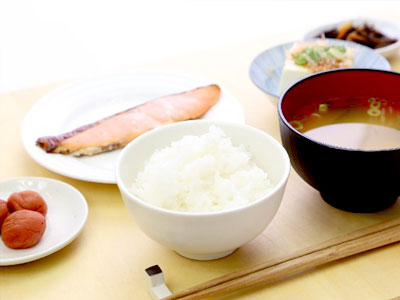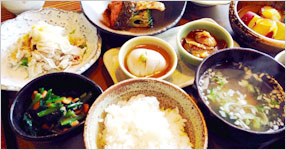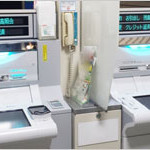Diversity of Japanese food

Japanese cuisine has been rapidly gaining popularity around the world over the last several years, particularly since Japan's traditional cuisine, known as 'Washoku', was added to UNESCO's Intangible Cultural Heritage list.
A cultural practice designed to reflect the spirit of nature, Washoku places a large emphasis on seasonal changes and aesthetic. Other than typical staples such as rice, pickled vegetables and broth (such as miso soup), it also usually features seasonal vegetables and seafood. The different elements of the meal are generally presented together on special decorative tableware consisting of several small plates and bowls. Preparing and seasoning the different elements is considered to take a lot of skill.
Despite Washoku's cultural heritage and significance, it is by no means the only type of food one can find in Japan. While sushi and tempura are the most well-known options abroad, other popular Japanese foods include:
Curry Rice – Originally from the UK, curry rice consists of meat and vegetables in a roux-based curry sauce with a side of rice. Unlike Indian curry, it is thinly-seasoned and only comes in a limited range of flavours and spiciness. A staple in any Japanese restaurant or family kitchen.
Donburi – These are bowls of rice topped with various things such as meat, seafood, egg or vegetables. A popular and good value dish to enjoy out or at home.
Okonomiyaki (Japanese-style 'pancake') – Okonomiyaki literally means something 'fried as you like it'. It consists of a pancake-like batter and the consumer's preferred combination of meat, seafood, vegetables, cheese, egg or even noodles. The ingredients are cooked layer by layer on a hot plate (usually in front of the customer) and then served up. There are two main styles—Hiroshima-style and Osaka-style.
Ramen – Ramen is one of the many types of popular noodle dishes around the country, consisting of noodles, meat and vegetables (among other things) in a broth. A popular Japanese-style 'fast food'.
Yakiniku – A do-it-yourself barbecue where you cook your own meat and vegetables on your table's inbuilt barbecue grill. Restaurants usually offer an all-you-can-eat course lasting 1-2 hours. Of course you could also do this at home on a hotplate.
Western Food in Japan
Western food is widely available across Japan, although it is often considered a 'Japanese-Western fusion' as the dishes often contain a 'Japanese' element to them.
For example, alongside some of the traditional pizzas from the west, many Japanese pizzerias also offer ones with Japanese-style toppings like seaweed or even ones with a fish-paste base instead of tomato. Similarly, you are more likely to find 'hamburgs' over 'hamburgers' outside of globalised chains such as McDonald's. Hamburgs (or Hamburg steaks) are ground-beef patties that are not served in baps, but instead served straight on a plate with sauce and usually a small side of vegetables and/or fries.
Ingredients commonly used in the west, such as red & white meat, pasta, milk, eggs, yoghurt and certain fruit & veg (when in season) are easily obtainable; however, other things like bread will differ in taste and/ or texture. Furthermore, some things like sweet potatoes or pumpkins are available, but only in Japanese varieties instead of American ones.
If there are certain (non-perishable) home necessities you can't do without, Japan's larger cities do have import stores dotted around; however, as the items in stock will differ between each store, you may want to ask other expats from your country that are living in that area of Japan to find out if a particular item is stocked.
Our tips:
However, we do not take responsibility should there be any inaccuracies or incorrect information shown.
Please use your own judgement about what you read here – From the organisers of japanbizguide.com





